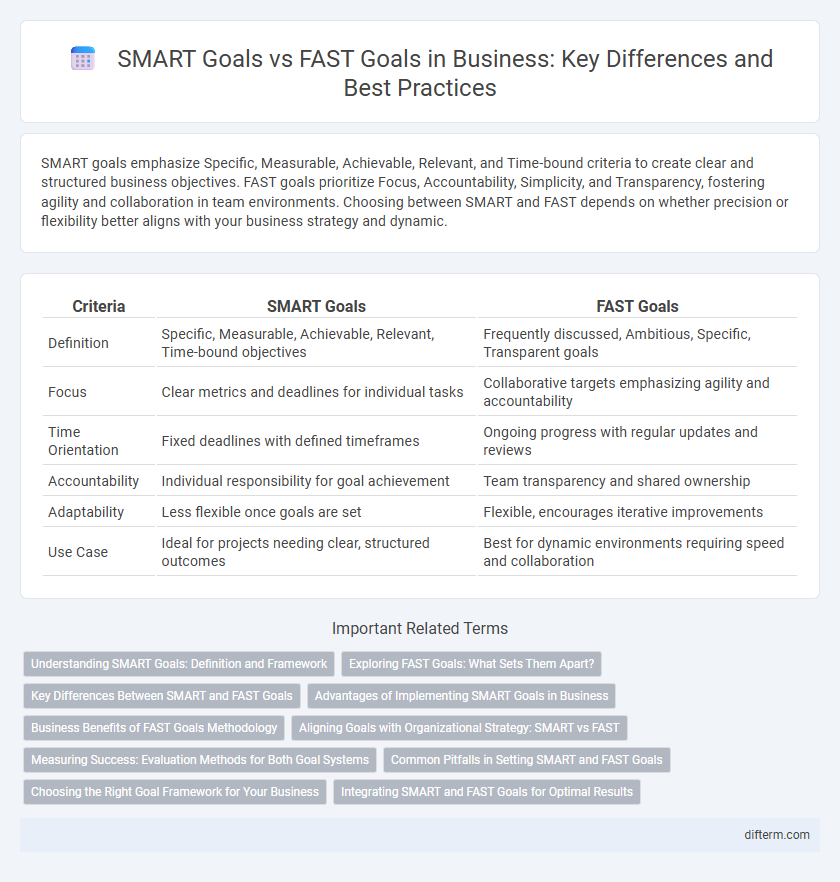SMART goals emphasize Specific, Measurable, Achievable, Relevant, and Time-bound criteria to create clear and structured business objectives. FAST goals prioritize Focus, Accountability, Simplicity, and Transparency, fostering agility and collaboration in team environments. Choosing between SMART and FAST depends on whether precision or flexibility better aligns with your business strategy and dynamic.
Table of Comparison
| Criteria | SMART Goals | FAST Goals |
|---|---|---|
| Definition | Specific, Measurable, Achievable, Relevant, Time-bound objectives | Frequently discussed, Ambitious, Specific, Transparent goals |
| Focus | Clear metrics and deadlines for individual tasks | Collaborative targets emphasizing agility and accountability |
| Time Orientation | Fixed deadlines with defined timeframes | Ongoing progress with regular updates and reviews |
| Accountability | Individual responsibility for goal achievement | Team transparency and shared ownership |
| Adaptability | Less flexible once goals are set | Flexible, encourages iterative improvements |
| Use Case | Ideal for projects needing clear, structured outcomes | Best for dynamic environments requiring speed and collaboration |
Understanding SMART Goals: Definition and Framework
SMART goals are a widely recognized framework in business for setting clear, measurable, and achievable objectives, emphasizing Specific, Measurable, Achievable, Relevant, and Time-bound criteria. This structured approach ensures goals are well-defined and trackable, promoting accountability and effective progress monitoring. By aligning tasks with SMART criteria, businesses enhance strategic planning and drive focused performance improvements.
Exploring FAST Goals: What Sets Them Apart?
FAST goals emphasize being Frequently discussed, Ambitious, Specific, and Transparent, promoting continuous alignment and adaptability in business environments. Unlike SMART goals, which focus on Specific, Measurable, Achievable, Relevant, and Time-bound criteria, FAST goals prioritize real-time collaboration and motivation. This approach drives higher engagement and faster execution, essential for dynamic markets and agile organizations.
Key Differences Between SMART and FAST Goals
SMART goals emphasize Specificity, Measurability, Achievability, Relevance, and Time-bound criteria to create clear and structured objectives. FAST goals focus on being Frequently discussed, Ambitious, Specific, and Transparent, promoting agility and continuous feedback within teams. The key difference lies in SMART's emphasis on individual, well-defined targets, while FAST prioritizes collaboration and dynamic progress tracking in business environments.
Advantages of Implementing SMART Goals in Business
Implementing SMART goals in business enhances clarity by defining objectives that are Specific, Measurable, Achievable, Relevant, and Time-bound, which drives focused efforts and accountability. This framework facilitates performance tracking and progress evaluation through quantifiable criteria, ensuring timely adjustments and resource allocation. Organizations experience improved strategic alignment and motivation, leading to increased productivity and goal attainment.
Business Benefits of FAST Goals Methodology
FAST goals methodology enhances business performance by prioritizing frequently discussed, ambitious, specific, and transparent objectives, fostering greater team alignment and accountability. Unlike SMART goals, FAST goals drive dynamic collaboration and adaptability, accelerating decision-making and execution in fast-paced markets. This approach improves organizational agility, boosting productivity and ensuring sustained competitive advantage.
Aligning Goals with Organizational Strategy: SMART vs FAST
Aligning goals with organizational strategy requires choosing frameworks that foster clarity and adaptability; SMART goals emphasize Specific, Measurable, Achievable, Relevant, and Time-bound criteria to ensure precise alignment. In contrast, FAST goals--Frequent, Ambitious, Specific, and Transparent--promote agility and ongoing progress tracking, crucial for dynamic business environments. Integrating SMART and FAST principles enhances strategic coherence while allowing flexibility to respond to market changes effectively.
Measuring Success: Evaluation Methods for Both Goal Systems
Evaluating success in SMART goals relies on specific, measurable criteria such as quantitative KPIs and deadlines, ensuring progress is trackable and outcomes are clear. FAST goals emphasize frequent, ambitious checkpoints with transparent progress reviews and team accountability to foster agility and continuous improvement. Combining SMART's precise metrics with FAST's dynamic feedback loops enhances overall effectiveness in business goal measurement.
Common Pitfalls in Setting SMART and FAST Goals
Common pitfalls in setting SMART goals include overly rigid criteria that limit flexibility and inadequate consideration of external factors affecting goal achievement. FAST goals, focusing on frequently discussed, ambitious, specific, and transparent targets, often encounter challenges due to insufficient alignment with organizational culture and lack of continuous feedback mechanisms. Both goal-setting frameworks risk failure when failing to balance measurability with adaptability and stakeholder engagement.
Choosing the Right Goal Framework for Your Business
Selecting the right goal framework for your business depends on aligning objectives with adaptability and motivation metrics. SMART goals emphasize Specific, Measurable, Achievable, Relevant, and Time-bound criteria, fostering clarity and accountability. FAST goals focus on being Frequent, Ambitious, Specific, and Transparent, promoting agility and continuous performance improvement in dynamic market environments.
Integrating SMART and FAST Goals for Optimal Results
Integrating SMART (Specific, Measurable, Achievable, Relevant, Time-bound) and FAST (Frequently discussed, Ambitious, Specific, Transparent) goals enhances business performance by combining structure with agility. SMART goals provide clear benchmarks for progress evaluation, while FAST goals promote continuous communication and alignment with dynamic market demands. This dual approach ensures precise objective-setting and adaptive execution, driving sustained organizational success.
SMART goals vs FAST goals Infographic

 difterm.com
difterm.com